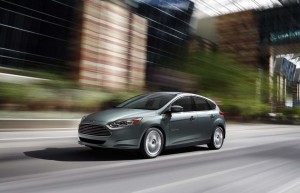According to some, the Mayan calendar predicts the world will end in December. Others now believe the apocalypse will arrive even sooner. On April 28th, to be precise, when Ford’s new Focus Electric serves as the pace car for the NASCAR race in Virginia.
The new battery car — which is just starting to roll into showrooms in a few select markets – is about to become the first electric vehicle to pace a Sprint Cup Series event. And proponents say it’s a sign that the new technology is coming of age.
“Highlighting the Focus Electric as a pace car is a fun way to educate consumers about the kinds of benefits our electrified vehicles deliver and show people our commitment to provide Ford customers the power of choice for leading fuel economy in the vehicle that best meets their needs,” proclaimed Mark Fields, Ford’s President of the Americas.
The public will get a first look at the Sprint Cup version of the new Focus Electric on April 25th. It will clearly get the requisite lights and other hardware, as well as a special paint and decal job for the event. It’s unclear if Ford will make any other modifications.
The Focus Electric is Ford’s first in-house battery-electric vehicle since a short-lived effort by the State of California to mandate electric vehicles back in the early 1990s. (The maker launched a battery version of its Transit Connect van in late 2010, but the driveline in that low-volume model has been installed by an outsider vendor, Azure Dynamics.)
The Focus Electric, which began reaching California dealers last December, uses a lithium-ion battery pack to provide up to 100 miles range under ideal conditions.
Ford is planning to roll out a number of other battery-based vehicles in the next few years, including plug-in hybrid versions of its midsize Fusion sedan and the new C-Max “people mover.” As with its competitors, Fields says that a key challenge is building awareness about the technology with consumers.
A new study by the Union of Concerned Scientists suggests that battery technology can outperform the best conventional powertrain technologies anywhere in the U.S., and for nearly half the country yield lower emissions – when powerplant smokestacks are included in the equation – than even the best hybrids. The UCS study claims that all American motorists would see a sharp reduction in energy costs – though other studies warn that it could take years for those savings to offset the added cost of the battery technology.
(For more on the UCS study, Click Here.)
Ford was also the first maker to provide a hybrid pace car for a NASCAR event, its Fusion Hybrid serving that duty at a 2008 race at the Miami-Homestead track.
Considering the mainstream audience NASCAR tends to deliver, the use of the Focus Electric could reach plenty of folks unfamiliar with battery power.
But NASCAR is by no means the only race car series exploring alternative propulsion. Formula One has been toying with the KERS kinetic hybrid technology and LeMans has seen a variety of alternative systems. Audi’s high-mileage diesel drive technology has helped the German maker dominate the endurance racing circuit for much of the last decade.
And last year, Formula One officials even hinted at the possibility of creating an entire electric vehicle race program though, so far, it hasn’t followed up with specific plans.

